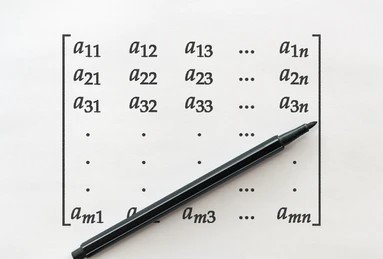Linear Vector Spaces - Linear Algebra (Undergraduate Advanced)
51
22 hrs
 MTH 202: Mathematical Methods IIComprehensive treatise of advanced mathematics covering vector calculus, complex numbers, linear vector spaces, linear maps, matrices, eigenvalues and eigenvectors.
Curated for second-year students of engineering and physical sciences at Obafemi Awolowo University, Ile-Ife, Nigeria. Students and professionals with similar learning goal will also find this learning track useful.
MTH 202: Mathematical Methods IIComprehensive treatise of advanced mathematics covering vector calculus, complex numbers, linear vector spaces, linear maps, matrices, eigenvalues and eigenvectors.
Curated for second-year students of engineering and physical sciences at Obafemi Awolowo University, Ile-Ife, Nigeria. Students and professionals with similar learning goal will also find this learning track useful.
Comprehensive treatise of advanced mathematics covering vector calculus, complex numbers, linear vector spaces, linear maps, matrices, eigenvalues and eigenvectors. Curated for second-year students of engineering and physical sciences at Obafemi Awolowo University, Ile-Ife, Nigeria. Students and professionals with similar learning goal will also find this learning track useful.
Course Chapters
1. Introduction9
Definition of a space, linear vector space, with examples.
Chapter lessons
1-2. Axioms, conjectures, theorems, etc.29:34
2. Vector Subspaces13
3. Linear Combinations and Spans34
Linear combinations of two or more vectors and linear spans of vector spaces.
Chapter lessons
4. Linear Dependence and Independence13
Linear dependence and independence of vectors in a vector space.
Chapter lessons
4-1. Definition18:57
Meaning of linear dependence and independence of vectors in a vector space.
5. Basis and Dimension13
Basis and dimension of linear vector spaces.
Chapter lessons
5-1. Definition12:52
Meaning of basis and dimension of a vector space.
6. Matrix Spaces3
Meaning, bases and dimensions of vector spaces derived from matrices - row, column and null spaces.
Chapter lessons
6-1. Row space20:57
Meaning and illustration of the row space of a matrix.
6-2. Column space39:26
Meaning and illustration of the column space of a matrix.
6-3. Null space33:33
Meaning and illustration of the null space of a matrix.
7. Sums and Intersections21
Sums and intersections of subspaces of a vector space - their basis, dimension and other properties.
Chapter lessons
7-1. Sums16:53
Meaning of the sum of two subspaces of a vector space.
7-2. Intersections8:43
Bases and dimensions of the sum and intersection of two subspaces of a vector space.
8. Coordinates11
Meaning of coordinates of a vector in a vector space with respect to a given basis, and how to find the coordinates.
Chapter lessons
8-1. Definition17:07
Meaning of the coordinates of a vector with respect to a given basis.